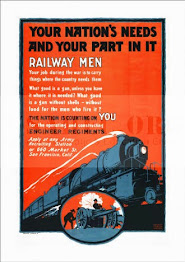Virgil's son, Bob writes...
I have attached 4 photos of my dad who was stationed with the 716th ROB in Germany at the end of WWII. I would like to send this to you, so it can be posted with other communications with ex-soldiers from his outfit. His name is Virgil Crowder. I don't know if this is the best way of doing this or not. If there is someone that knew him, I would be willing to communicate with them.

716th Railway Operating Battalion - Virgil Cowder
Sunday, January 28, 2018 | Labels: 716th Railway Operating Battalion | 1 Comments
ACTCOTS (Atlantic Coast Transportation Corps Officers' Training School) 1943 4th Class
ACTCOTS (Atlantic Coast Transportation Corps Officers' Training School) 1943 4th Class by Nancy on Scribd
Monday, January 15, 2018 | Labels: Atlantic Coast Training Corps Officer Training School, Fort Slocum | 0 Comments
764th Railway Shop Battalion -- Major Wooten
Major Wooten's family is working on digitizing more of his photos - thanks to them for sharing!

Monday, January 15, 2018 | Labels: 764th Railway Battalion | 0 Comments
Newfoundland Railway Unit -- Lend Lease
Newfoundland Railway Lend Lease by Nancy on Scribd
Monday, January 15, 2018 | Labels: locomotives | 0 Comments
Affiliated Railway Units WWII
Affiliated Railway Units WWII by Nancy on Scribd
Monday, January 15, 2018 | Labels: documents, Railroad company, World War II pt 2 | 0 Comments
Military Service Records, Awards, and Unit Histories: A Guide to Locating Sources 2018 Update by Mese F. DeBruyne and Barbara Salazar Torreon.
The guide provides information on locating military unit histories and individual service records of discharged, retired, and deceased military personnel. It also provides information on locating and replacing military awards and medals. Included is contact information for military history centers, websites for additional sources of research, and a bibliography of other publications, including related CRS reports.
Military Service Records, Awards, and Unit Histories: A Guide to Locating Sources 2018 update by Mese F. D... by Nancy on Scribd
Wednesday, January 10, 2018 | Labels: research | 0 Comments
The Military Railway Service in Italy and Northwest Europe. MAJ GEN C. R. Gray, Jr., US Army Military Review, June 1948.
The Military Railway Service in Italy and Northwest Europe. MAJ GEN C. R. Gray, Jr., US Army Military Rev... by Nancy on Scribd
Monday, January 01, 2018 | Labels: articles | 0 Comments
Military Railway Service in World War II. LT COL Jefferson H. Myers, TC
Military Railway Service in World War II. LT COL Jefferson H. Myers, TC Military Review, February 1945.
Military Railway Service in World War II. LT COL Jefferson H. Myers, TC by Nancy on Scribd
Monday, January 01, 2018 | Labels: articles | 0 Comments
The Military Railway Service up to the Italian Campaign. MAJ GEN C. R. Gray, Jr., US Army
The Military Railway Service up to the Italian Campaign. MAJ GEN C. R. Gray, Jr., US Army Military Review, May 1948.
The Military Railway Service up to the Italian Campaign. MAJ GEN C. R. Gray, Jr., US Army by Nancy on Scribd
Monday, January 01, 2018 | Labels: articles | 0 Comments
Development of Military Railway Service. MAJ George E. Lourie, TC
Military Review, September 1946.
Development of Military Railway Service. MAJ George E. Lourie, TC by Nancy on Scribd
Monday, January 01, 2018 | Labels: articles | 0 Comments
Role of Army railroading at the operational level of war.
by Smith, Bradley E. Little emphasis is being placed upon military railroading today by Defense Department planners. Rail is overshadowed by motor transport and theater air when it comes to supporting large unit operations. In doing that, logisticians may be shortchanging themselves and, worse still, the units they are obligated to support. A new look at Army railroading at the operational level of war is warranted because little has been written about it over the last several decades.
Current terminology, doctrine and capabilities are summarized before further analysis is undertaken. The Army's present railroad doctrine is based upon the assumption that the present day equivalent of the Military Railway Service, which is the Transportation Railway Service, will be small in comparison to our efforts in World War II and the Korean conflict. In fact, our reliance upon host nation rail support is at an all time high. Foreign nationals will have to be assigned missions that soldiers have traditionally done in past wars. A reevaluation of Army railroading at the operational level of war is warranted before any realignment of doctrine and force structure is initiated. This paper is an attempt to make a contribution toward that end. The first step in that approach is to explore inherent advantages of rail from the standpoint of a theater commander. The second step is to examine railroad challenges confronting the operational commander and his staff. It is concluded that this mode of transportation warrants much more attention and consideration than it is currently receiving. Operational commanders have a great deal to gain from increasing the number of U.S. Army rail units.
The advantages of rail outweigh any likely difficulties which might result from its use. To gain a true appreciation of rail, however, further analysis is required. Strengths and weaknesses of different transport modes need to be examined and quantified. Systemic comparisons need to be drawn so our logistical efforts can be better focused and directed. The appropriate place for military rail must be identified and the necessary personnel and equipment obtained. This is an important step which we can take now which will help to meet the pressing demands that are likely to be placed upon our logistical support structure in the future
Role of Army railroading at the operational level of war. by Nancy on Scribd
Monday, January 01, 2018 | Labels: documents, Transportation Corps | 0 Comments
Employment of the Transportation Corps - Railway Operating Battalion in an Invasion by Carroll C.Mullen
Mullen, Carroll C.
A practical study of echelonment, employment and command control of Military Service troops, TC, in preparation for and during initial phases of an invasion.
Employment of the T. C. Railway Operating Battalion in an invasion. by Nancy on Scribd
Monday, January 01, 2018 | Labels: book, documents, Transportation Corps | 0 Comments







